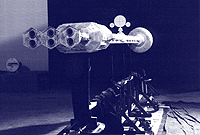Spotlight : April 1998

Spotlight : April 1998

Pederson (cont'd):So coming back to your question, these are more or less the circumstances by which I got to work on the movie. The first thing Doug worked on was the "moon base", which he detailed out very
meticulously. He and I had done miniature work, where we had begun to develop the
idea of using parts from model kits, because they were very detailed and you
could mix and match them in a way that you could create a very realistic surface. We
had used the technique a lot building spacecraft models for the Air Force and NASA,
and I had worked in the Army for Wernher von Braun, so I was used to a lot of
blueprints. In fact I had worked with designs of what eventually became the Apollo
project. I was very familiar with rocketry and rocket design from the inside out. I
had been always very interested in model rocketry since I was a kid.
Pederson: Aside from those of us who had some familiarity with spacecraft design up to that
point, specifically Mercury, Gemini--anything that used Redstone rockets which is
what I was pretty familiar with--I guess it was what von Braun had wanted to do. I
had worked in a space series at Disney that von Braun had designed along with Willie
Ley that was about the way they envisioned things would look like 50 years in the
future. But I think it was basically guesswork.
Debert: What did Stanley Kubrick contribute in the design phase?
Pederson: Mainly his incredible eye. He had started as a photographer, as many people know,
and had ventured into film work when he was rather young. He has an amazing eye for
detail, and that has something to do with his obsession with using really sharp lenses. He wanted to use Panavision cameras with Nikon lenses, therefore we almost didn't use
Panavision lenses. We shot most of the interiors with a 28mm. He brings an amazing
enthusiasm to every production he undertakes, and takes a minimum of four to five
years on every picture he's done, and involved a lot of research in his part. He is
very knowledgeable about what he's going to do, and would not hesitate in getting
experts around.
Debert: Was there any struggle to be visually interesting and realistic at the same time?
Pederson: Stanley has a principle that roughly is that there's three factors to consider in
a film, and they are: Interesting, believable, and beautiful or aesthetically superior. And he had to have at least two of those three in every shot. This is probably a distortion of what he was, but he was always concerned about every corner of the film, unlike Hitchcock who would basically turn the camera over to the photographer and
assume that it was going to be the way the storyboard showed. Stanley always looked
through the camera and always made changes, and was making sure that his sense for the film was coming through.
When he talked about what he wanted, it was often a feeling-out process to see how we were going to do something we were not quite clear about. Since the script was in many "The scene in which the stewardess comes out the door and then walks around the walls
of the Shuttle was tricky too."
The scene in which the stewardess comes out the door and then walks around the walls
of the Shuttle was tricky too. But it was all based in the fact that this wheel was
physically built. The same goes for the scene in which Keir Dullea (Bowman) is jogging in the main spherical habitat of Discovery. One of the biggest problems on that set was the 16mm projectors that were used to
project into all the tiny screens with readouts of the HAL 9000. All those little
screens had animated graphics on them. It turned out that some of the projectors were
equipped with bulbs that couldn't burn upside down, so they had to find bulbs that
could run in those positions without blowing out, since all the projectors were built
in the back side of the set. Nobody had run those projectors upside down before.
Those are the little things that you never think about, until you are there.
Debert: That actually leads to my second question, which is what kind of references,
either technical or aesthetic, did you use in the movie?.


The 11' model of the Discovery photographed on stage, and a frame from 2001.
cases very clear--for instance the sequence of going to
the space port, and from there to the Moon--the layout was very detailed. In other
aspects the shooting was conventional, except for the fact that many of the sets were
specially built and had mechanical principals involved. The rotating centrifugal
spaceport station itself, which was built by the Vickers Corporation, involved a 40
foot section. The trick on that was that we put a wide eye lens on the floor, and the
floor consisted of swinging panels and it would allow the camera to move forward or
backwards as the centrifugal wheel rotated. So in shots in which you would see the
actor walking, what was actually happening was that he was walking in place, and the
whole set was moving. And the swinging panels would open to let the camera pass, and
close immediately after to give the appearance of solid ground. Although the system was sometimes problematic because the panels would not always work,
that was the way all those sequences were shot.
Back to the Spotlight Main Menu

. . VFX HQ Produced by Todd Vaziri . . http://www.vfxhq.com . . e-mail: tvaziri@gmail.com . .
All text Copyright © 1998 Todd Vaziri, unless otherwise noted